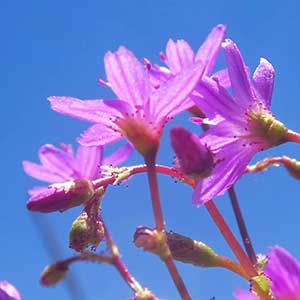Lewisia leeana
Lewisia stebbinsii
many flower lewisia, quill-leaf lewisia
Stebbins' lewisia
gradually ramified distally.
gradually ramified distally.
spreading or suberect, 8–20 cm.
procumbent, 1.5–14 cm.
basal leaves evergreen, sessile, blade linear, ± terete, 1.5–6 cm, margins entire, apex obtuse;
cauline leaves alternate, intergrading with bracts, blade narrowly lanceolate, 5 mm, margins entire, apex acute.
basal leaves withering after anthesis, gradually tapered to broad petiole, blade oblanceolate, spatulate, or obovate, flattened, 2.5–8.5 cm, margins entire, apex obtuse;
cauline leaves absent.
paniculate cymes, 50–70(–100)-flowered;
bracts several, alternate proximally, 2 at each flowering node distally, ovate to narrowly lanceolate, 2–5 mm, margins glandular-toothed, apex acute.
subumbellate cymes, 1–3-branched, 3–11-flowered;
bracts several, usually an opposite pair proximally, plus 2 at each flowering node distally, ovate to elliptical, 1.8–3 mm, margins glandular-toothed, apex acute.
pedicellate, not disarticulate in fruit;
sepals 2, suborbiculate, 1–4 mm, herbaceous at anthesis, margins glandular-toothed, apex truncate;
petals 5–8, magenta, lavender, or white with or without magenta veins, obovate, 5–7 mm;
stamens 4–8;
stigmas 2;
pedicel 3–15 mm.
pedicellate, not disarticulate in fruit;
sepals 2, broadly ovate, 3.5–7 mm, herbaceous at anthesis, margins glandular-toothed, apex rounded to truncate;
petals 7–10, magenta or carmine with whitish bases, veins darker, oblanceolate or obovate, 8–10 mm;
stamens 10–13;
stigmas 3–4;
pedicel 8–25 mm.
4–5 mm.
5–7 mm.
1–2, 2–2.5 mm, shiny, smooth.
20, 1.5–2 mm, shiny, smooth.
= 14.
Lewisia leeana
Lewisia stebbinsii
Lewisia leeana is known only from northwestern California and southwesternmost Oregon, and a disjunct population in Fresno County, California. As discussed by B. Mathew (1989b), Lewisia ×whiteae Purdy (California) is a natural, constantly recurring hybrid between L. leeana and L. cotyledon. In their narrowly spatulate leaves, the hybrids resemble L. columbiana out of range (cf. L. T. Dempster 1993); the flowers are reportedly more deeply colored.
(Discussion copyrighted by Flora of North America; reprinted with permission.)
Of conservation concern.
Lewisia stebbinsii is known only from the north Coast Ranges in Mendocino County
(Discussion copyrighted by Flora of North America; reprinted with permission.)


